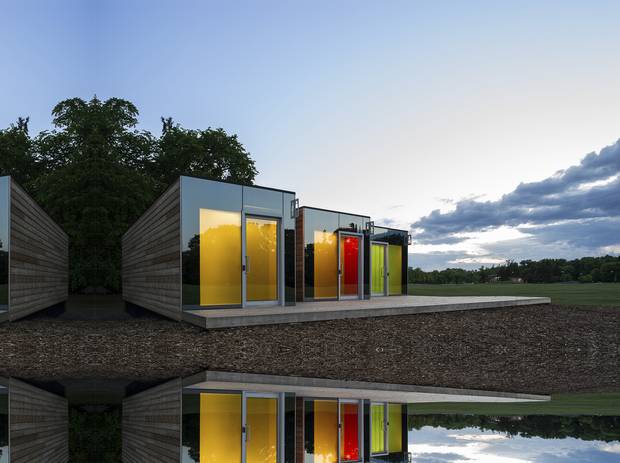From across the country, they came: In a loft space in downtown Toronto, a group of youngish designers from Quebec and Newfoundland and Queen Street West crowded around photographs and models, talking shop. Canada's design culture was being built before my eyes, one beer and one anecdote at a time.
Most of the crowd were part of Twenty + Change: Next Generation, an exhibition, with an accompanying catalogue, that captures some of Canada's best up-and-coming architects, urban designers and landscape architects.
"This means a lot to an office like ours," said the Newfoundland architect Chris Woodford. He'd flown in with his partner Taryn Sheppard and intern architect Jessica Stanford. Woodford Sheppard are among the 13 design firms featured in this year's exhibition and the accompanying book.
There were maybe 200 people in the room – but these are some of the people who will be building Canada's future, and they were getting a meaningful boost.

Work by UUfie.
"Even having the book in the office matters," Woodford told me this week from St. John's. "When clients come by, we show it to them. We've been published! Most of our buildings are still going up, so this seems to give us a new level of legitimacy."
Like most 20+C winners, they practise architecture, and that is a tough line of work. It's an art that has an impact on all of our lives; it's also a profession in which it's absurdly difficult to get launched. To call yourself an architect requires a master's degree and then several years of poorly paid apprenticeship. Then you have to find clients and, often, explain to them just what it is you do.
The goal of 20+C is to change that climate. "There's a lot of work we need to do to help people understand the value of design," says Toronto architect Heather Dubbeldam, the director of the 20+C initiative. "And, in Canada, we need to develop a conversation across the country. … This is kick-starting a new awareness."

Work by Marianne Amodio Architecture Studio.
The exhibition, the only one of its kind in the country, has a real impact on Canadian culture. Yet it has been driven largely by volunteer work and led by two people with other jobs: Lola Sheppard, a University of Waterloo professor and partner at Lateral Office, who co-curated the last two exhibitions, and Dubbeldam.
I served on the curatorial committee this year, and we looked through more than 60 submissions – some of them from firms I'd never heard of, such as Woodford Sheppard, and many displaying remarkable skill and ambition. "Architecture," as Dubbeldam puts it, "has a long chrysalis period" – the work takes time, and it's difficult to find clients who will bet on ambition and youth. Especially in Canada. This is why architecture has its own peculiar category, "emerging," for those people in their 30s or even 40s who are still rising toward their best work.

Work by Peter Sampson Architecture Studio.
Still, this year's submissions showed a youngish crop of designers who are building with creativity and hustle. Vancouver's Scott and Scott are twisting the wood-heavy tradition of Canadian modern architecture in novel directions. A few, such as the Toronto office JA Architect Studio, are designing inventive forms while becoming developers themselves.
They will go on to make an impact, if history is any guide. This is the fourth iteration of the show; the first, in 2007, covered design in Toronto, and was founded by the office Superkul. It was succeeded by Canada-wide versions in 2009 and 2011. Some of the designers who were included have enjoyed a rapid rise since then, including Winnipeg's 5468796 Architecture, which won a prize at last year's World Architecture Festival, and Toronto's PARTISANS, which was shortlisted there this year. Those two firms share a fearlessness and entrepreneurial spirit that have pushed them toward strong designs and toward clients.
And yet even for people like this – who are capable, ambitious and in any other business would be storming to success – a stamp of approval matters. "Design is such an award-driven and media-driven field; there is a sense of celebrity," says Monica Adair of the St. John firm Acre Architects, which has been featured by 20+C in the past. "It's always nice when you have a project and you get recognized as being able to do great things. You have the potential to be at the table."

Work by Polymétis.
In the national scene, 20+C "is important in identifying and boosting the profile of young, talented designers and firms," says Elsa Lam, the editor of Canadian Architect magazine. "Like startups in all fields, new design firms bring fresh ideas to the table," she says, "but they need material and moral support to succeed in taking their businesses to the next level."
That support is rare: Canada has very little public conversation about contemporary architecture, never mind the work of emerging firms. We have no national museum of design or building. And while the Canada Council for the Arts has awards programs, and supports architecture events and publications such as 20+C, it has relatively little money to work with.

Work by Architecture Microclimat.
Canada's lack of attention to design is a strategic error. Promoting design is something that other countries see as a matter of cultural diplomacy and economic development; at a trade show this week, I received a handsome package promoting Spanish architecture and product design. The Canadian Government doesn't do this. And Canadian architects are also hampered by their own professional culture, which sees self-promotion (and indeed any talk of money) as uncouth.
Dubbeldam, the co-director of 20+C and a friend of mine, is a reflection of that culture. She is a gifted and thoughtful architect – and perversely modest about her accomplishments. In Winnipeg in 2014, I saw her speak at a national architects' convention about a dozen "emerging firms." Not including her own. "I could have talked about my work," she told me this week with a laugh, "but it wouldn't have felt right."
Who flies halfway across the country to promote other people's work? A curator, not a businessperson. And yet Dubbeldam also does run a business, full-time and then some; she routinely sends e-mails at midnight. Her office, founded in 2002, now employs six people and is hiring; they have moved on from house renovations to designing office spaces and hotels. She has no spare time. Then why does she do it? To make a difference.
And that is what makes great landscapes and great places: people who care passionately – who believe that they are not just service providers, but artists and citizens.
"It's our responsibility, as architects," Dubbeldam said, "to make sure that architecture rises to the level of art."
Twenty + Change: Next Generation runs at Urbanspace Gallery in Toronto through Feb. 6. The catalogue is available from Riverside Architectural Press.
